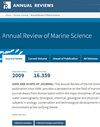Symbiotic Ammonia Oxidation in the Marine Environment.
IF 18.9
1区 地球科学
Q1 GEOCHEMISTRY & GEOPHYSICS
引用次数: 0
Abstract
Ammonia oxidation is a fundamental step in the marine nitrogen cycle, catalyzing the conversion of ammonia to nitrite or nitric oxide and generating reductive power for the autotrophic growth of microorganisms. The ecology, diversity, and properties of ammonia-oxidizing microbes in the ocean's plankton have been extensively studied, but these microbes can also live in association or symbiosis with marine hosts such as sponges, corals, jellyfish, bivalves, and crustaceans. Sequencing-based studies have revealed that ammonia-oxidizing archaea of the family Nitrosopumilaceae are prevalent in various marine hosts, although other taxa are also found and coexist within the same host. Ammonia oxidation rates are highly variable between host species, even between closely related taxa. Limited knowledge is available on the metabolic interactions that ammonia-oxidizing microbes have, but theoretical considerations indicate that they could make significant contributions to carbon fixation for their hosts. Additionally, ammonia-oxidizing microbes appear to also have undergone specific genomic adaptations to their host environment, and the hosts may also enable ammonia oxidation to occur in habitats where planktonic counterparts might be limited. This review identifies key knowledge gaps and highlights the need for further research to fully understand the ecological significance of symbiotic ammonia oxidation in marine ecosystems.海洋环境中的共生氨氧化。
氨氧化是海洋氮循环的一个基本步骤,它催化氨转化为亚硝酸盐或一氧化氮,并为微生物自养生长产生还原力。海洋浮游生物中氨氧化微生物的生态学、多样性和特性已经得到了广泛的研究,但这些微生物也可以与海绵、珊瑚、水母、双壳类和甲壳类等海洋宿主联合或共生。基于测序的研究表明,亚硝化菌科的氨氧化古菌普遍存在于各种海洋宿主中,尽管在同一宿主中也发现了其他分类群并共存。氨氧化速率在宿主物种之间是高度可变的,甚至在密切相关的分类群之间也是如此。关于氨氧化微生物的代谢相互作用的知识有限,但理论上的考虑表明,它们可以为宿主的碳固定做出重大贡献。此外,氨氧化微生物似乎也经历了对其宿主环境的特定基因组适应,宿主也可能使氨氧化发生在浮游生物可能有限的栖息地。这篇综述指出了关键的知识空白,并强调了进一步研究的必要性,以充分了解海洋生态系统中共生氨氧化的生态意义。
本文章由计算机程序翻译,如有差异,请以英文原文为准。
求助全文
约1分钟内获得全文
求助全文
来源期刊

Annual Review of Marine Science
地学-地球化学与地球物理
CiteScore
33.60
自引率
0.60%
发文量
40
期刊介绍:
The Annual Review of Marine Science, published since 2009, offers a comprehensive overview of the field. It covers various disciplines, including coastal and blue water oceanography (biological, chemical, geological, and physical), ecology, conservation, and technological advancements related to the marine environment. The journal's transition from gated to open access through Annual Reviews' Subscribe to Open program ensures that all articles are available under a CC BY license, promoting wider accessibility and dissemination of knowledge.
 求助内容:
求助内容: 应助结果提醒方式:
应助结果提醒方式:


